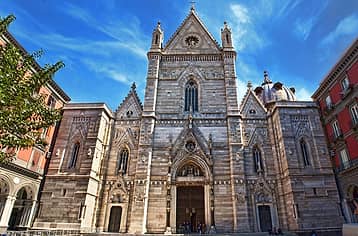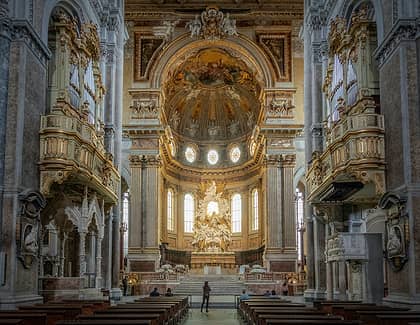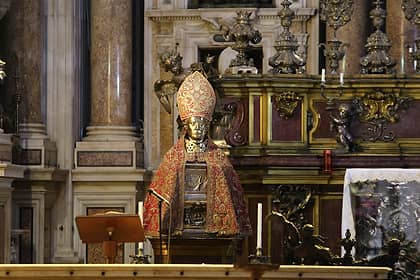The Naples Duomo and the Treasure of San Gennaro


Tickets to the Museum of the Treasure of San Gennaro
Officially the Cattedrale di Santa Maria Assunta (Cathedral of Santa Maria Assunta), Naples’ most famous and beloved church is commonly known as simply the Duomo. The hub of Neapolitan spiritual life, the Naples Cathedral is also home to the annual miraculous liquefaction of the blood of patron saint, San Gennaro, one of the city’s cultural touchstones.
The Duomo di Napoli is the seat of the archdiocese and has a complex history that stretches back almost 1,000 years. It houses two additional religious buildings, which were incorporated into the design of the cathedral and now serve as two side chapels: the Basilica of Santa Restituta, with the ancient Baptistery of San Giovanni; and the Chapel of the Treasure of San Gennaro, where the relics of the beloved patron of the city are kept.
No walking tour of Naples is complete without a stop at its spectacular cathedral. Here’s all you need to know to get the most out of your visit.
Naples Duomo tickets and opening hours
Naples Duomo tickets and opening hours
The church itself is free to enter; audioguides to the Chapel of San Gennaro are €5/each.
Opening Hours of the church:
Monday to Saturday 9:30 am - 5:00 pm; Sunday and public holidays 9:00 am - 5:00 pm
You can book a free guided tour by writing to prenotazioni@muddnapoli.it.
Opening Hours of the Chapel of San Gennaro:
Monday and Saturday: 9:30 am–1:00 pm (last admission 12:30 pm)/ 3:00 pm–6:00 pm (last admission 5:30 pm)
Tuesday to Friday: 9:30 am–1:00 pm (last admission 12:30 pm)/ 2:30 pm–6:00 pm (last admission 5:30 pm)
Sunday: 9:00 am–1:00 pm (last admission 12:30 pm) / 4:30 pm–6:00 pm (last admission 5:30 pm)
You must purchase a ticket to visit the Museum of the Treasure of San Gennaro.
Opening Hours: daily 9:30 am to 6:00 pm (last entrance 5:00 pm).
Tickets: €13; €9.5 for over 65 and companions of disabled visitors; free for under 12 and disabled visitors; audioguide included.
You can book a guided tour of the Museum of the Treasure for €25/person, or combined tickets with the Filangieri Museum
A brief history of the Duomo in Naples
A brief history of the Duomo in Naples
The construction of the Cathedral began in the 13th century when the city was under Angevin rule, but several religious buildings had already occupied the site for centuries. The Basilica of Santa Restituta and another early Christian church - known as the Basilica Stefania and built on the ruins of a Roman temple probably dedicated to the god Apollo - both stood here when the construction of the new cathedral was commissioned by King Charles II of Anjou.
The king entrusted the design to French and Italian architects, including Giovanni and Nicola Pisano, and the cathedral was completed during the reign of his son Roberto in 1314.
Over the centuries, the Cathedral of Naples has survived collapses, bombings, earthquakes, and a series of renovations in various architectural styles. The interiors, the apse, and the facade have been modified or rebuilt several times, first in the Gothic style, then in the Baroque style, and finally in the current Neo-Gothic style designed by Enrico Alvino.
In 1497, Cardinal Oliviero Carafa decided to add the Succorpo Chapel, a crypt with decorations by Tommaso Malvito, to house the relics of San Gennaro when they were returned to the city. Further restorations were needed after the Allied bombing of WWII.
The cathedral legend: There once stood a large bronze equestrian statue just outside the former cathedral, said to have been magically created by Virgil and endowed with the miraculous power to heal sick horses. In an attempt to put an end to the superstition, the statue was removed in 1332 by Cardinal Filomarino, who had it melted down to make the bells of the new cathedral.
Highlights inside the Naples Duomo
Highlights inside the Naples Duomo

The Neapolitan Cathedral is laid out in a Latin cross plan with three naves and several side chapels. The central nave, about 100 meters long and 35 meters high, has a beautiful coffered ceiling with 17th-century paintings. The nave walls are decorated with works by Luca Giordano depicting apostles, doctors of the Roman Catholic Church, and the patron saints of Naples.
The counter-façade houses the tombs of Angevin rulers including Charles I of Anjou and Carlo Martello, while the transept houses burial markers, bas-reliefs, and sculptures from various eras. The main altar is decorated with bas-reliefs and houses relics of a number of saints.
Basilica di Santa Restituta
Along the left aisle and after the third chapel stands the oldest early Christian basilica in Naples, the Basilica of Santa Restituta. This ancient church dates back to the 4th century and was incorporated into the Cathedral of Naples when it was built almost 1,000 years later; it is decorated with 14th-century works by Luca Giordano. The basilica leads to the Baptistery of San Giovanni in Fonte, which may have been built by Emperor Constantine.
The Chapel of the Treasury of San Gennaro
The Chapel of the Treasury sits along the right aisle of the cathedral and houses the relics of San Gennaro (Saint Januarius), including bones and two ampoules containing what is believed to be the saint's blood. The chapel was built in a Greek cross plan by the architect Francesco Grimaldi following the vow made by the Neapolitans to the patron saint during the terrible plague of 1526 and is decorated with ornate frescoes.
Cappella Capece Minutolo
This marvelous Gothic-Angevin chapel is one of the most important in the church. Stop to admire the 14th-century triptych and the fabulous mosaic floor.
The Museum of the Treasury of San Gennaro
The Museo del Tesoro di San Gennaro is located next to the Duomo and houses sacred vestments and other objects which, according to tradition, belonged to the patron saint of Naples, plus sacred furnishings and works of art.
But the true masterpiece of the museum is the jeweled Miter of San Gennaro, one of the most precious art objects in the world. The headdress is, in fact, studded with 3,694 precious stones: 198 emeralds, 168 rubies and 3,328 diamonds, mounted to compose a design of flowers and leaves.
The museum’s audio guide was created with the voices and music of famous Neapolitan actors, musicians, and writers, including Toni Servillo, Maurizio de Giovanni, Pietra Montercorvino, and Eugenio Bennato. It is available in several languages, including the Neapolitan dialect.
The miraculous liquefaction of the blood of San Gennaro
The miraculous liquefaction of the blood of San Gennaro

San Gennaro, patron saint of the city affectionately known by the Neapolitans as "Face 'Ngialluta" (or “Yellow Face”, from the color of the golden bust of the saint that is carried in procession), was a bishop of Benevento who lived between the 2nd and 3rd centuries. According to tradition, at the martyr’s beheading, a pious woman named Eusebia collected his blood in two ampoules, which today are kept in the safe behind the altar of the Royal Chapel of the Treasury of San Gennaro. Three times a year the archbishop of Naples removes them from the safe during a solemn ceremony and shakes them until the blood miraculously liquifies. This rite is performed in front of a huge crowd of the city’s faithful, municipal authorities, and women believed to be the descendants of Eusebia, who hasten the miracle with song. The Roman Catholic Church has never recognized the phenomenon as miraculous, but it sanctions its popular veneration.
One of the two ampoules is almost full, while the other is almost empty. King Charles of Bourbon took part of the contents with him when he left Italy for Spain to become regent there.
The liquefaction of the blood of San Gennaro is considered by Neapolitans to be a good omen, while the lack of liquefaction is seen as a sign of terrible events to come. According to popular belief, "Yellow Face" also saved the city of Naples from the eruption of Mt. Vesuvius in 1631, when the lava flow stopped right in front of the saint's relics carried in procession on the volcano.
The miracle of liquefaction takes place on the 19th of September, the Saturday before the first Sunday in May, and on the 16th of December. If you intend to attend the ritual, be prepared to face a huge crowd of the faithful, the curious, and unsuspecting tourists. Reach the Duomo early in the morning to find a spot inside and be patient!
How to get to the Naples Duomo
How to get to the Naples Duomo
The Cathedral of Santa Maria Assunta is located at Via Duomo 147, in the historic center of the city. You can easily reach it with the metro line 1, getting off at the Museum, Dante, or Piazza Cavour stops (which is also on line 2). The Duomo is within easy reach of many other important sites in the city, such as the Sansevero Chapel, the cloister of Santa Chiara, and the Royal Palace.
Book Tickets to the Museum of the Treasure of San Gennaro
FAQ - Frequently asked questions
How much does it cost to visit the Naples Duomo?
The Cathedral of Naples is free to enter. A paid audio guide is available for the Chapel of the Treasure of San Gennaro.
What is the name of the Church of San Gennaro in Naples?
The Naples Duomo, which houses the blood of San Gennaro, is called the Cathedral of Santa Maria Assunta.
Which church in Naples houses the blood of San Gennaro?
The relics of San Gennaro, including the ampoules containing the blood that liquifies three times a year, are kept in the Naples Duomo (cathedral), inside the Chapel of the Treasure of San Gennaro.
What are the best places to eat near the Naples Duomo?
The Cathedral of Naples is located in the heart of the city, which is full of great pizzerias, restaurants, trattorias, and street food options. Here is our list of the top pizzerias.